
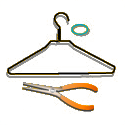
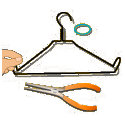
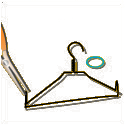
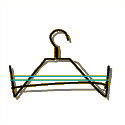

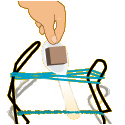
Experiment Category:
Objective:
What You Need:
- 1 wire coat hanger
- 2 or more sturdy (1/4” wide) rubber bands
- paper plate
- marker
- pliers
- 1 plastic spoon
- 1 kitchen sponge
- scissors
To Do and Observe:
1. Lay the coat hanger on the table in front of you, hook side away from you.
2. Bend the two “wings” of the hanger vertically, so that the middle part of the hanger lies flat on the table and the wings stand straight up.
3. Use pliers to squeeze each wing so that the angle is smaller, and the wing becomes more narrow. Then use pliers to bend wings and angle them out wider, spreading slightly away from each other and from eth center of the hanger (this helps keep the rubber bands from slipping off later).
4. Slide a rubber band down over the two wings so that it is stretched between them. It should be tight, but have some give. If too tight or too lose, try a different rubber band.
5. Slip the handle of a plastic spoon between the two strips of the rubber band, and start winding the spoon to twist up the band. You’re finished when the spoon feels “springy” and tries to spin if you release it.
6. Now slide a second rubber band over the wings of the coat hanger, don’t slide it down as far as the first one. This band acts as a “stop” to keep the spoon from unwinding when you let it go.
7. Adjust the spoon and the two bands until the lower, twisted band is about 1” from the end of the spoon handle, and when released, the spoon hits the upper, untwisted band where the bowl joins the handle. If the convex side of the spoon in is facing the wrong way, turn the spoon in the twisted band until the concave side is the one facing up.
8. Now use a pair of scissors to cut the kitchen sponge into cubes, and use the marker to draw a target on the paper plate. Set up the target and use your catapult to try and hit the target with a sponge cube. NEVER use catapult to launch hard, heavy or sharp projectiles as these can cause serious eye injury.
9. Experiment with alterations to your design: Instead of just letting the spoon strike the rubber band, try sliding the spoon between the two strips of the upper band. Try changing the position on the spoon in the rubber bands, or use the pliers to change the angle of the wings. Try wetting the sponge cube with water. Do these changes this effect performance? Why, what’s happening?
What's Going On:
When you use your catapult to launch a cube you are transforming Potential into Kinetic Energy. Potential Energy can be defined as stored energy and Kinetic Energy can be defined as energy of motion. When you twist the rubber band, tension is created and stored in the twisted band. When the spoon is stretched back against the rubber band, the spoon as well as the sponge has its greatest Potential Energy. When the spoon is let go then the Potential Energy is then converted into Kinetic Energy. The Potential Energy of the spoon is then transferred into Kinetic Energy of the sponge as described by Newton’s first law: An object in motion (in the spoon) tends to stay in motion (flying through the air after the spoon was stopped by the top rubber band) unless an external force is applied to it (for example, gravity, which will eventually ground your sponge cube).
Parent/Teacher Tips:
NEVER use catapult to launch hard, heavy or sharp projectiles as these can cause serious eye injury. For Older Students Students can experiment by altering variables of catapult design one by one and making predictions about the impact of each alteration. They may try different types of rubber bands, or vary the number of times they twist their bands. Will the object be projected further or will it go a lesser distance? Students can make observations, measure height and distance of projected object and graph the results of their design experiments.
